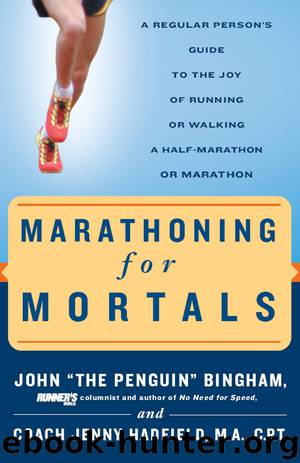Marathoning for Mortals by John Bingham

Author:John Bingham
Language: eng
Format: epub
Publisher: Potter/Ten Speed/Harmony/Rodale
Published: 2014-05-11T04:00:00+00:00
That’s our top three. With luck and patience, you’ll never have to deal with any of them. But if you are not so patient and not so lucky, you’ll need to know a few additional things to help you get through the frustration of an injury.
The Care and Feeding of the Body
Unless you’ve recently arrived from the planet Xenon, you’ve probably heard about RICE therapy. No, not long grain and steamed rice—RICE rice: rest, ice, compression, and elevation. With all the advances in medical treatment, with all the miracle drugs on the market, for the most common injuries there’s still nothing that works better than rest, ice, compression, and elevation.
R is for REST. At the onset of an injury—notice the word onset—stop what you’re doing and rest. Nothing good is going to happen if you keep training with an injury. Our own rule of thumb is to take 3 days off. Three days. Three full days. That means if it hurts on Monday, you take Tuesday, Wednesday, and Thursday off and see how it feels on Friday. (We know you. You figure if it hurts on Monday, that’s one day. Then Tuesday is a second day and Wednesday is the third, so you can run on Thursday. Not.)
In many cases, the inflammation that was causing the pain will subside substantially in 3 days. If it doesn’t, take 3 more days off. If it still hurts, it’s time to get professional help.
I is for ICE. Whether you suffer a traumatic injury, like a sprained ankle, or an overuse injury, like those we just described, get ice on the affected area as soon as possible. The sooner you get ice on an injury, the sooner you will stop the inflammation response and the sooner you will begin to heal and recover.
Keep ice on the injury for about 10 to 20 minutes. What you’re trying to do is (1) get the inflammation to subside and (2) get the blood vessels to constrict. After 20 minutes, take the ice away and let the area warm up completely. This will encourage increased blood flow, which will speed up the healing and recovery.
Repeat this cycle of ice/warmup a few times, and try to do it two or three times a day for the 3 days that you are resting.
C is for COMPRESSION. Compression works best for acute injuries, such as ankle sprains. Wrapping your ankle as soon as you sprain it will squeeze out inflammation, preventing fluids from accumulating in your ankle and causing pain and stiffness. However, for the vast majority of overuse injuries, you need to get to the root of the problem and solve it. Compression only provides a short-term solution.
E is for ELEVATION. Again, for us as distance athletes, the kind of injuries we’re most likely to face won’t require elevation. Again, sprained ankles provide the most obvious exception.
Download
This site does not store any files on its server. We only index and link to content provided by other sites. Please contact the content providers to delete copyright contents if any and email us, we'll remove relevant links or contents immediately.
Born to Run: by Christopher McDougall(6894)
Bodyweight Strength Training Anatomy by Bret Contreras(4466)
Dynamic Alignment Through Imagery by Eric Franklin(3919)
Men's Health Best by Men's Health Magazine(2389)
The Coregasm Workout by Debby Herbenick(2127)
Starting Strength by Rippetoe Mark(2015)
Relentless by Tim S Grover(1999)
Bigger Faster Stronger by Greg Shepard(1897)
Endure by Alex Hutchinson(1872)
Core Performance Essentials by Mark Verstegen(1860)
Weight Training by Thomas Baechle(1675)
Relentless: From Good to Great to Unstoppable by Tim S Grover(1590)
The Stretching Bible by Lexie Williamson(1503)
Practical Programming for Strength Training by Mark Rippetoe & Andy Baker(1466)
The Spartan Way by Joe De Sena(1434)
Good to Go by Christie Aschwanden(1389)
Dr. Jordan Metzl's Running Strong by Jordan Metzl(1330)
The Art of Throwing by Amante P. Marinas Sr(1303)
Total Hockey Training by Sean Skahan(1283)
